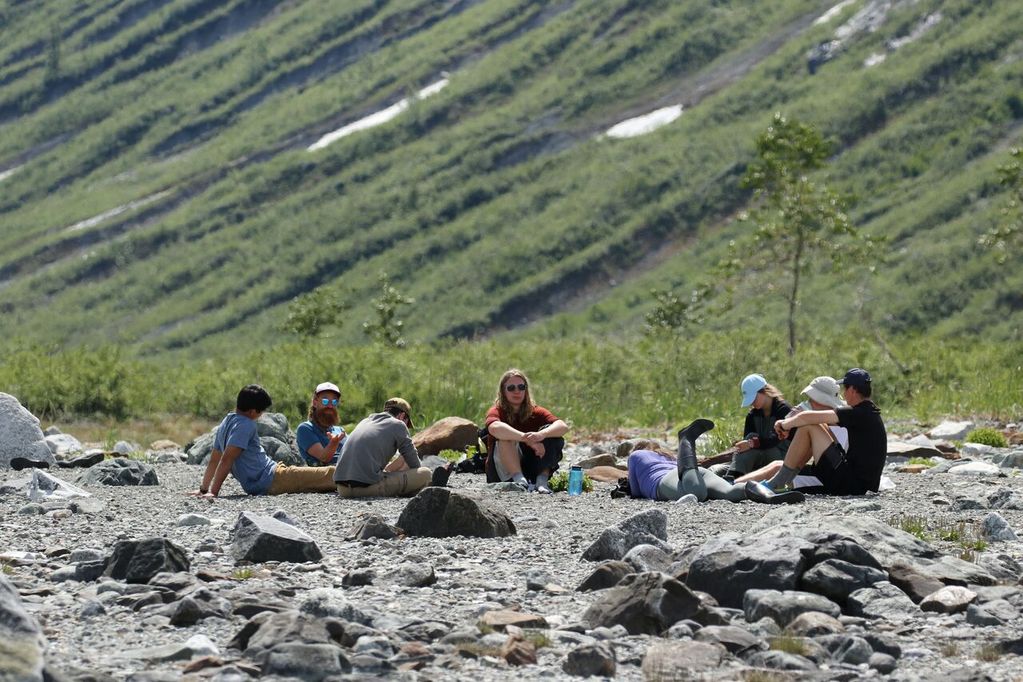The Wildest Thing

By Ian Ramsey
It's nearly subarctic midnight and I'm running, stumbling across a ridge top with four eighteen-year-old boys. Jake, Xander, Michael, Jack and I just ran, crawled, jumped, and scrambled nearly two thousand feet up this small peak on the steep shoulder of an inlet deep in Alaska's Glacier Bay.
With dirty boots and blazing lungs, we're howling and laughing, bushwacking higher and higher through krummholz until we come to a stop on a cliff, looking down across miles of steep fjords. The sun's cauldron-red halo glows from behind the snowy ramparts of the Fairweather range. It's not just the purple light on the unfathomable glaciers and sprawling fjords, but also seeing these young men, brawny with testosterone and fire, shocked into a silent awe. It might be the most beautiful thing I've ever seen.

I'm in Glacier Bay, leading a group of teenagers as part of an environmental writing class that I teach. After a semester of reading and writing and learning about everything from Ed Abbey ("Dude. I really like his freeballin' attitude.") to backcountry bear protocols ("Really? We're not supposed to run away from a ten-foot bear? How does that even work?"), we got on a plane in Boston and flew to a tiny town in Alaska where salmon is used as currency just as much as dollars and where there might be more moose than people. After 36 hours of intense trip prep packing a crazy amount of food (don't forget all those eighteen-year-old boys) into bear canisters, getting outfitted, and packing dry bags, we were dropped off alone with our kayaks on a rocky shore in the west arm of Glacier Bay, nearly fifty miles from a road, deep into a twenty-four million acre wilderness area that includes not only Glacier Bay, but also Wrangell St Elias National Park and Canada's Kluane and Tatsenshini-Alsek National Parks.
We've spent the past week paddling among icebergs, accidently burning tortillas over tippy campstoves, gawking at mountains, napping in sun, huddling in rain, writing in journals, and making stupid amounts of coffee. "Night" is merely a three hour dusk, so our circadian rhythms are more determined by tides and weather than by our watches. For the past three nights, we've been camped on the side of an inlet with two tidewater glaciers and endless mountains in view. Last night, just as we were going to bed, a humpback whale surfaced just offshore, and the kids ran, barefoot, groggy and cheering, to stand at the rocky shore, watching this unknowable creature bigger than a tractor trailer as it peacefully dove and surfaced. Putting teenagers deep in the backcountry might be the wildest thing on earth.

Far from college placement, AP statistics and the distraction of I-Phones, these kids transform, becoming both more childlike and more adult. When there are bears and icebergs and no easy out, they become more responsible, but they also drop pretense and open up to their own weirdness. They expressive the wild electricity of adolescence in healthy ways. They think about their lives and they feel what it is to be part of something much bigger than themselves. They discover forgotten parts of themselves. They become a tribe. As an educator, I increasingly believe in the importance of community and consequences, where kids have to work together when there is something at stake. Where they have to dig deep and push through challenges, and support others. The complexity and honesty of wilderness brings out meaning and feeling that that they will carry forward throughout their lives.
The night before we went out into the bay, we spent an evening with author Kim Heacox and his wife Melanie. Longtime residents, activists and National Park Service employees, they embody exactly the kind of dedicated passionate joy that I wish for my students. As we sat in their beautiful hand-built house late into the Alaskan summer twilight, we played music and ate pizza and Kim and Melanie told the kids about Glacier Bay, about the importance of wilderness, of wildness, of wisdom. As one of the kids said that night, "Wow. Getting older isn't a problem if you're doing things that you love and believe in. I guess that's how you stay young." The trip was already a success before we went out onto the Bay.
But back to this silent moment with these boys, standing on the edge of the world, watching the dusk draw down with a relentless clarity. After many minutes, one of the boys speaks up, "We have to protect this so that someday I can bring my children here to experience this." A pair of ravens fly below us, gurgling and cackling, before disappearing behind a cusp of cliff.
In a few days we will leave Alaska and scatter to our assorted summers, to cell phones and schedules. These kids will go off to college, and I'll start to work with another group of students. There are so very many small things that I will remember about them: The way they giggled and danced like toddlers on the edge of a glacier, painting their faces in glacial silt and chewing on ice older than agriculture. How they took care of each other. The way they stepped up to carry boats and cook dinner. Mostly, I'll remember standing on this pinnacle with these boys and a handful of other perfect moments, when we stepped into a shared presence with the wild earth, touching something unknowable, something greater. Those are the kind of experiences that help you to build a life.

Photo Credit: Brian Beard
1 comment
HI Ian: Thank you for a wonderful memory of Michael’s Alaska trip with you and friends last year .
Miss you.